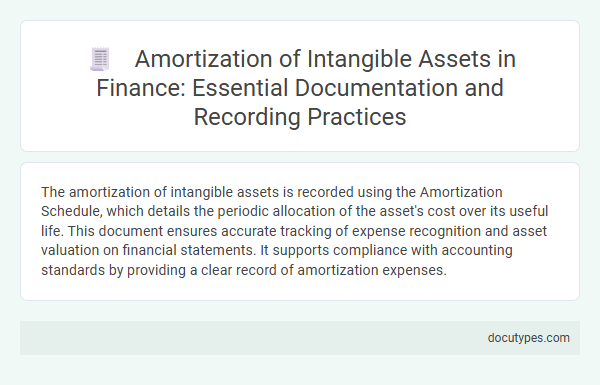The amortization of intangible assets is recorded using the Amortization Schedule, which details the periodic allocation of the asset's cost over its useful life. This document ensures accurate tracking of expense recognition and asset valuation on financial statements. It supports compliance with accounting standards by providing a clear record of amortization expenses.
Introduction to Amortization of Intangible Assets
Amortization of intangible assets refers to the systematic allocation of the cost of non-physical assets over their useful life. This process helps businesses match expenses with the revenue generated by these assets. The primary document used to record amortization is the amortization schedule, which details the periodic expense amounts and remaining asset value.
Key Intangible Assets Subject to Amortization
Amortization of intangible assets is recorded in specific financial documents to ensure accurate accounting and compliance. The key intangible assets subject to amortization include patents, copyrights, and trademarks.
- Amortization Schedule - Lists periodic amortization expenses and the remaining book value of intangible assets over their useful life.
- General Ledger - Records all amortization entries as part of the company's financial transactions.
- Financial Statements - Reflect amortization expenses impacting net income and asset values on the balance sheet and income statement.
Proper documentation of intangible asset amortization ensures transparent financial reporting and asset management.
Regulatory Framework and Compliance Requirements
| Topic | Details |
|---|---|
| Document Used | Amortization Schedule or Amortization Ledger for Intangible Assets |
| Purpose | To systematically record the periodic allocation of the cost of intangible assets over their useful life |
| Key Regulatory Frameworks |
|
| Compliance Requirements |
|
| Reporting | Amortization expenses must be accurately reflected in the income statement and intangible asset book value on the balance sheet |
Methods for Calculating Amortization Expense
The document used to record the amortization of intangible assets is the amortization schedule or amortization ledger. This record tracks the systematic allocation of the asset's cost over its useful life.
Methods for calculating amortization expense include the straight-line method, which evenly spreads the cost over the asset's estimated useful life. Another approach is the units of production method, where amortization is based on the asset's usage or output during a period. Your choice of method will impact the timing and amount of amortization expense recorded in your financial statements.
Essential Documentation for Amortization Schedules
The essential document used to record amortization of intangible assets is the amortization schedule. This schedule details the systematic allocation of the intangible asset's cost over its useful life.
Your accounting records must include the amortization schedule to ensure accurate financial reporting and compliance with relevant accounting standards. It typically contains information such as the asset's initial cost, useful life, amortization method, and periodic amortization expense.
Recording Amortization in Financial Statements
Amortization of intangible assets is recorded using the amortization schedule document to ensure accurate tracking. Your financial statements reflect this amortization to show the asset's decreasing value over time.
- Amortization Schedule - This document details the periodic amortization expense for each intangible asset.
- Income Statement - The amortization expense is recorded here, reducing net income accordingly.
- Balance Sheet - The accumulated amortization is presented as a contra-asset, decreasing the intangible assets' book value.
Best Practices for Maintaining Accurate Records
Amortization of intangible assets is typically recorded in the amortization schedule, a key document that tracks the gradual expense allocation over the asset's useful life. Best practices for maintaining accurate records include regularly updating the schedule, ensuring consistency with accounting standards, and reconciling it with financial statements. You should keep detailed documentation to support amortization calculations and facilitate audits or financial reviews.
Common Documentation Challenges and Solutions
In finance, the amortization of intangible assets is typically recorded using an amortization schedule or journal entries within the general ledger. These documents track the systematic allocation of the asset's cost over its useful life, ensuring compliance with accounting standards such as IAS 38 or ASC 350.
Common documentation challenges include accurately estimating the useful life and residual value of intangible assets, which can lead to inconsistent amortization schedules. Solutions involve regular reviews, employing robust valuation methods, and maintaining detailed records to support adjustments and audit trails.
Audit Preparation and Supporting Documentation
The document used to record the amortization of intangible assets is the Amortization Schedule, which details the systematic allocation of the intangible asset's cost over its useful life. This schedule supports accurate financial reporting and is essential for audit preparation by providing clear evidence of amortization expenses.
Maintaining appropriate supporting documentation such as the original asset acquisition records and amortization journal entries ensures the audit trail is complete and verifiable. Proper documentation reduces audit risks and enhances transparency in intangible asset management.
- Amortization Schedule - A detailed record showing the periodic amortization expense and accumulated amortization balances for each intangible asset.
- Journal Entries - Accounting records capturing the amortization expense postings to the general ledger, verifying the reduction of asset value.
- Supporting Documents - Asset acquisition agreements, valuation reports, and amortization policy documents that validate the amortization calculations and compliance.
Which Document Is Used to Record Amortization of Intangible Assets? Infographic

